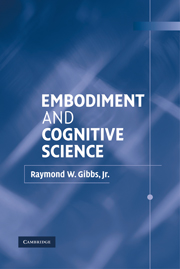- Type
- Chapter
- Information
- Embodiment and Cognitive Science , pp. 283 - 324Publisher: Cambridge University PressPrint publication year: 2005
22 August 2024: Due to technical disruption, we are experiencing some delays to publication. We are working to restore services and apologise for the inconvenience. For further updates please visit our website: https://www.cambridge.org/universitypress/about-us/news-and-blogs/cambridge-university-press-publishing-update-following-technical-disruption



